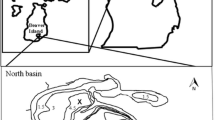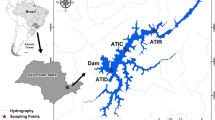Abstract
Background and Scope
Lake sediment contains information on the historical development and former conditions of lakes, which is very useful when information about the undisturbed (reference) conditions of a lake is needed. Phytoplankton contains a range of different pigments, some of which are specific for individual algal groups and can be used as diagnostic markers. Phytoplankton pigments in lake sediments are indicators of prototrophic changes in lakes, since the pigments document changes in algae biomass and the composition of phytoplankton communities. Lake sediments can be dated along with pigment analysis by use of the naturally occurring radioactive isotope210Pb.
Objectives
The objective was to describe the historical development and the former ecological state of two shallow Danish lakes — Lake Ladegaard and Lake Nr. Soeby.
Method
Sediment was sampled either in Plexiglas cores using a Kajak sediment sampler or by use of a peat sampler. The cores were cut into 2-cm slices. Sub-samples were taken from each slice for210Pb dating, and for determining the pigment content through HPLC analysis.
Results and Discussion
The results of the datings were excellent and there was a very strong linear relation between sediment age and the depth of both lakes (r2 = 0,99). The results of the pigment analyses in Lake Ladegaard revealed a distinct eutrophication initiated in the beginning of the 1930’s. Prior to this period, the phytoplankton diversity was high, with a predominance of chromophyte algae. In Lake Nr. Soeby, the phytoplankton biomass was relatively high not only in the upper part of the sediment but also in the lowest part of the sediment. Heavy eutrophication took place between 1950 and 1980, when the biomass of chlorophytes and cyanobacteria increased. Prior to this eutrophication event, the phytoplankton population had been more varied with a relatively low amount of chlorophytes and cyanobacteria and a higher abundance of chromophyte algae.
Conclusions
210Pb dating combined with the analysis of phytoplankton pigments in sediment cores from two Danish lakes — Lake Ladegaard and Lake Nr. Soeby — turned out to be a simple but effective method of describing the historical development and the past ecological state of the lakes. The pigment content of the sediment showed that Lake Ladegaard and Lake Nr. Soeby were exposed to intense eutrophication during the 20th century. It also showed that the ecological state of the lakes was better in former times, with a much higher algal diversity and lower algal biomass.
Recommendations and Outlook
Before beginning the restoration of the lakes it is useful to know the ecological conditions to which it is possible to bring the lakes. The investigations showed that Lake Ladegaard and Lake Nr. Soeby before the 1930’s and 1950’s respectively were in another ecological state, and it might therefore be possible to return the lakes to these past ecological levels through lake restoration activities. If the investigations had shown that the original eutrophication level of the lake was the same as the present eutrophication level, then restoration activities would be pointless.
Similar content being viewed by others
References
Directive 2000/60/EC of the European Parlament and of the Coucnil of 23 October 2000: Establishing a framework for Community action in the field of water policy. OJ L 327, 22.12.2000, 1–72
Leavitt PR, Carpenter SR, Kitchell JF (1989): Whole-lake experiments — The annual record of fossil pigments and zooplankton. Limnol Oceanogr 34, 700–717
Leavitt PR, Sanford PR, Carpenter SR, Kitchell JF (1994): An annual fossil record of production, planktivory and piscivory during whole-lake manipulations. J Paleolimnol 11, 132–149
Jeffrey SW, Mantoura RFC, Wright SW (1997): Phytoplankton pigments in oceanography: Guidelines to modern methods. UNESCO Publishing
Schmidt H, Bauer F, Stich HB (1998): Determination of algal biomass with HPLC pigment analysis from lakes of different trophic state in comparison to microscopically measured biomass. J Plankt Res 20 (9) 1651–1661
Schlüter L, Møhlenberg F, Havskum H, Larsen S (2000): The use of phytoplankton pigments for identifying and quantifying phytoplankton groups in coastal areas: testing the influence of light and nutrients on pigment/chlorophyll a ratios. Mar Ecol Prog Ser 192, 49–63
Leavitt PR, Findlay DL (1994): Comparison of fossil pigments with 20 years of phytoplankton data from eutrophic Lake 227, Experimental Lakes Area, Ontario. Can J Fish Aquat Sci 51, 2286–2299
Pheiffer Madsen P, Sørensen J (1979): Validation of the lead-210 Dating Method. J Radioanal Chem 54, 39–48
Christensen ER (1982): A Model for Radionuclides in Sediment Influenced by Mixing and Compaction. J of Geophysical Research 87, 566–572
Christensen ER, Bhunia PK (1986): Modeling Radiotracers in Sediments: Comparison with Observations in Lakes Huron and Michigan. J of Geophysical Research 91, 8559–8571
Ringkoebing County (2001): Ladegaard Lake — Environmental State and Development. Report to the County of Ringkoebing (in Danish)
Fyn County (2001): Aquatic Environment of Fyn, Denmark, 1976-2000. Streams and lakes, coastal waters, groundwater, environmental impact of wastewater and agriculture. Fyn County, Odense, Denmark, pp 148
Jensen A, Larsen B (1998): Models used in Connection with210Pb Dating of Sediment Cores from the Gulf of Riga. Report to Nordic Environment Research Programme — Nordic Council of Ministers, pp 12
Wright SW, Jeffrey SW, Mantoura RFC, Llewellyn CA, Bjørnland T, Repeta D, Welschmeyer N (1991): Improved HPLC method for the analysis of chlorophylls and carotenoids from marine phytoplankton. Mar Ecol Prog Ser 77, 183–196
Yacobi YZ, Mantoura RFC, Llewellyn CA (1991): The distribution of chlorophylls, carotenoids and their breakdown products in Lake Kinneret (Israel) sediments. Freshwater Biology 26, 1–10
Leavitt PR (1993): A review of factors that regulate carotenoid and chlorophyll deposition and fossil pigment abundance. J Paleolimnol 9, 109–127
Goodwin TW (1980): The biochemistry of the carotenoids. 2nd ed, Vol 1. London: Chapman and Hall
Author information
Authors and Affiliations
Corresponding author
Rights and permissions
About this article
Cite this article
Mortensen, P.B., Schlüter, L., Jensen, A. et al. Historical development and past ecological state of two danish shallow lakes. J Soils & Sediments 4, 101–106 (2004). https://doi.org/10.1007/BF02991053
Received:
Accepted:
Issue Date:
DOI: https://doi.org/10.1007/BF02991053




